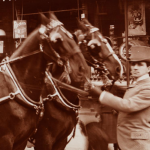The PSWG blog this week presents a curated series of responses to Carolee Klimchock’s paper ‘Humor Hung Like a Horse: Coachmen and Coaches as Satirical Sites for Discussions of Class and Power in the Gilded Age’. Carolee has selected for us a group of objects of performance around which her research is crystallizing. By ‘objects of performance’ we mean things which embody, depict, surrogate, reflect, describe or resonate with a performance in the past and which constitute the focus of our critical attention. They could be films, audio recordings, clothes, anecdotes, buildings, gestures and so on- in short, objects by which we know the presence- or disappearance- of a performance. In this case Carolee has chosen a set of photographs and anecdotes.
You are welcome to extend the conversation.
******************************************************************************************************************************************
“An Ill Matched Coachman”
“A Philadelphia lady is in deep distress concerning her coachman. She returned from a drive in very dejected spirits the other day and explained the cause to a friend by saying:–“I sent clear to South Carolina to get a man to match my brougham. He was a real olive green, and I was delighted all summer. Why, you don’t know how many congratulations I received on my taste at the City Troop races! But now the cold weather comes he turns that nasty grey. The wretch, I believe he knew he would.”—
(New York Herald, 1885)
******************************************************************************************************************************************
“In selecting his coachman, a man should be as careful as in the purchase of a horse…If he is young and good-looking he will elope with his employer’s daughter.”
Chicago Daily Tribune, 1900.
******************************************************************************************************************************************
“Matrimony is becoming a more stable institution, judging from the numerous coachmen elopements.”
The World, 1888
******************************************************************************************************************************************









